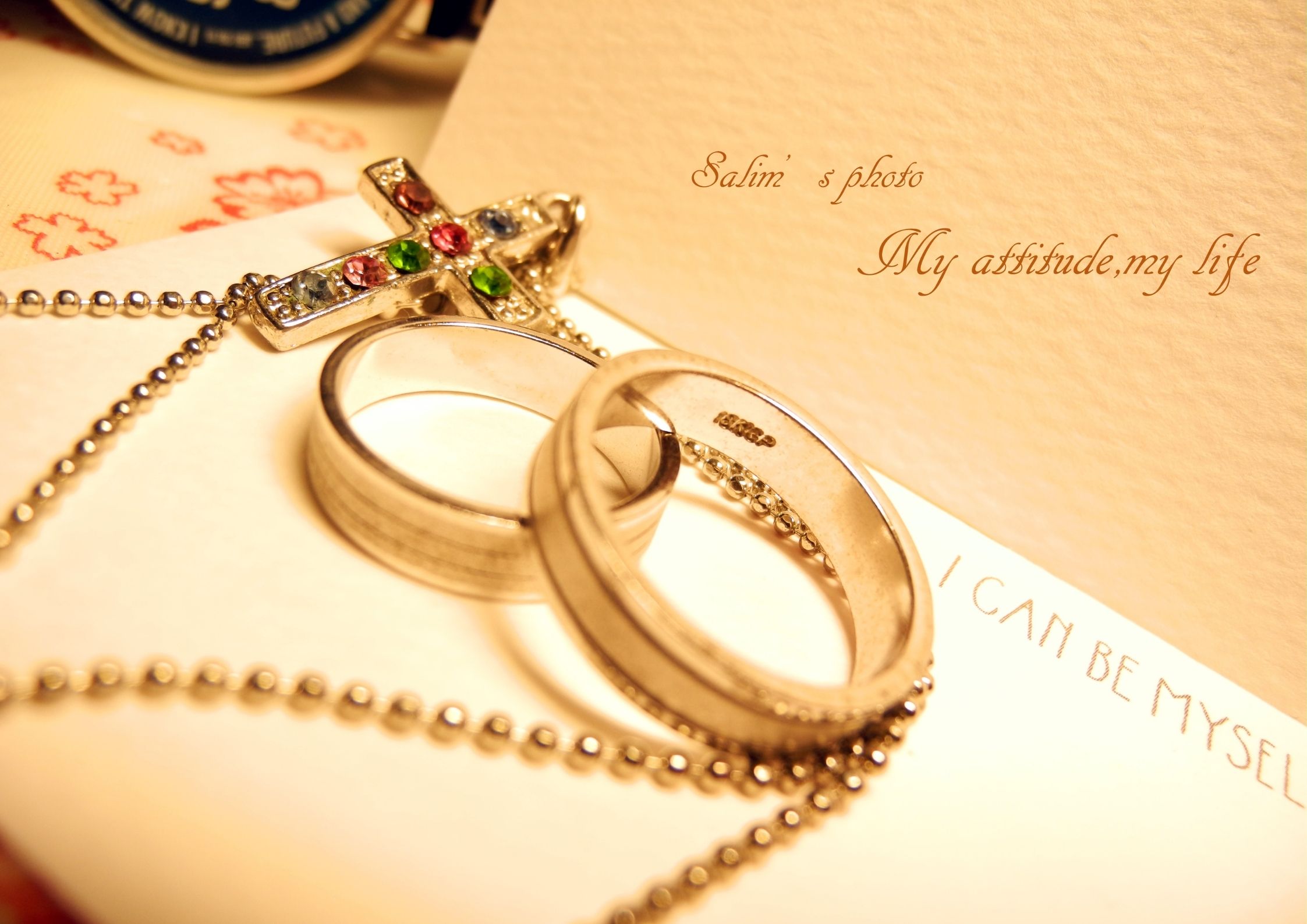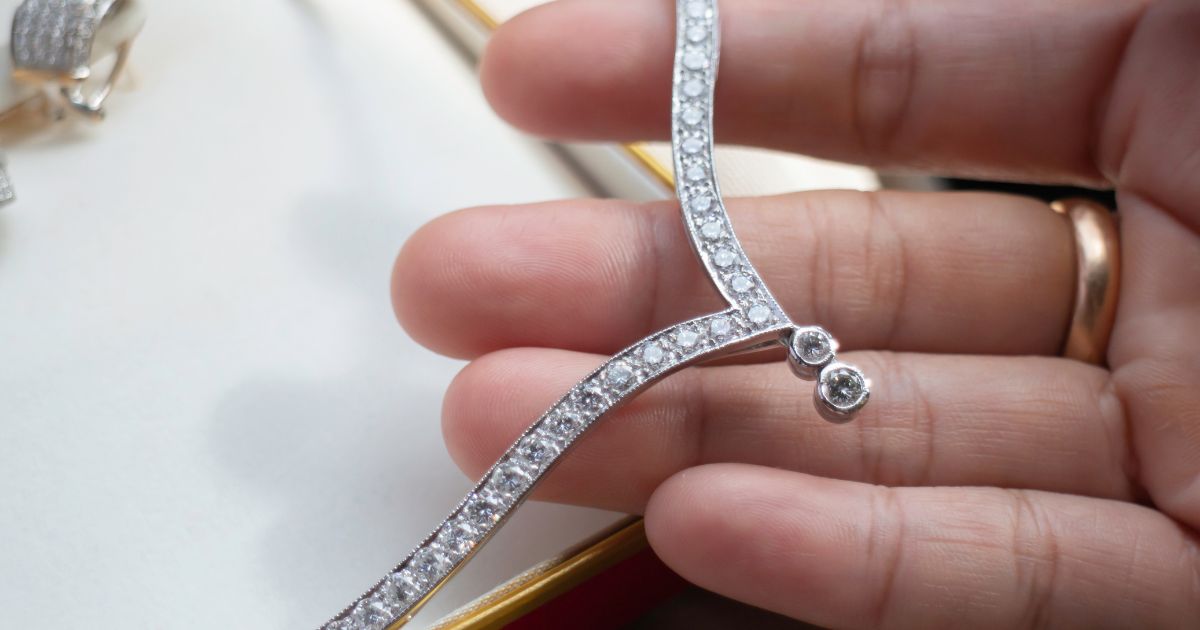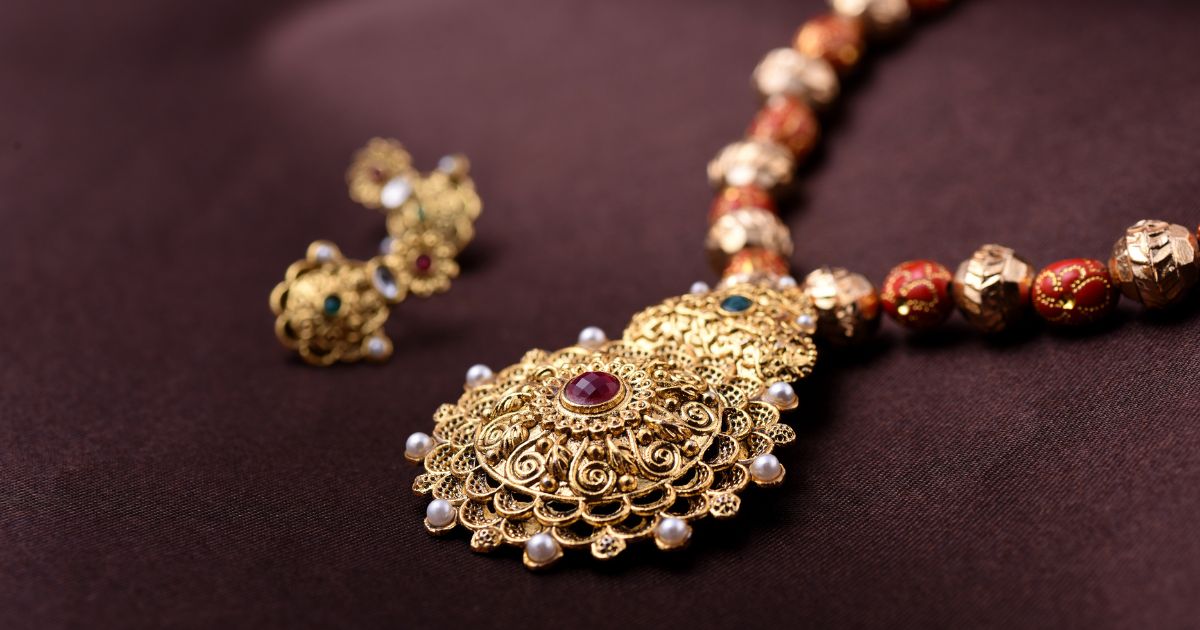- Key Takeaways
- Pioneers in Indian Jewellery Design
- Showcasing Unique Indian Craftsmanship
- The Best of Indian Jewellery Designers
- Vogue’s Favorite Jewelry Brands
- Notable Female Jewellery Designers
- Instagram-Worthy Jewellery Designers
- Contemporary Jewelry Designs
- Timeless Creations by Jewellery Designers
- Trendsetting Indian Jewellery Designers
- Conclusion
- Frequently Asked Questions
Jewellery designers are the architects of fine jewelry, shaping India’s rich cultural heritage into stunning couture adorned with gold earrings and gemstones. The Indian fine jewelry landscape is a breathtaking fusion of tradition and innovation, where opulent designs featuring gemstones narrate stories of bygone eras while embracing contemporary allure. From exquisite necklaces to stunning earrings, the craftsmanship and artistry of Indian jewelry truly shine.
These famous jewellery designers have not only earned global recognition in the luxury jewellery industry for their intricate craftsmanship, but have also set trends that resonate across borders with their fine jewellery. Their trendsetting designs of luxury jewellery effortlessly blend timeless sophistication with modern flair, captivating connoisseurs of fine jewellery worldwide. These famous jewellery designers are known for their exquisite creations.
Key Takeaways
- Explore the rich heritage of Indian jewellery by discovering the pioneers and trendsetting designers in the industry.
- Embrace the unique craftsmanship and creativity of Indian jewellery designers, showcasing their exceptional artistry and attention to detail.
- Discover the best and most notable jewellery brands and designers, as recognized by Vogue and other reputable sources.
- Recognize the significant contributions of female jewellery designers, who have made a mark in the industry with their innovative and inspiring creations.
- Stay updated with the latest contemporary and Instagram-worthy jewellery designs, reflecting the evolving trends and styles in the world of jewellery.
- Appreciate the timeless and trendsetting creations by Indian jewellery designers, offering a perfect blend of tradition and modernity.
Pioneers in Indian Jewellery Design
Timeless Innovators
Jewellery designers have played a crucial role in shaping the landscape of Indian jewelry design, creating stunning pieces like necklaces, earrings, and bracelets. These famous jewellery designers are celebrated for their ability to blend traditional craftsmanship with contemporary aesthetics, producing luxury jewellery pieces that resonate with modern consumers while honoring India’s rich cultural heritage.
Timeless innovators such as Sabyasachi Mukherjee and Tarun Tahiliani have redefined the concept of bridal jewelry, infusing it with fresh designs that appeal to the younger generation. These designs include stunning necklaces, earrings, and karat gold pieces.
These luxury jewelry designers draw inspiration from various sources, including historical artifacts, nature, and even everyday objects. Their designs feature exquisite necklaces and earrings. By incorporating these diverse influences, the jewellery designer creates unique luxury jewellery pieces that stand out in the crowded marketplace.
The brand’s jewelry is truly exceptional. For example, Sabyasachi Mukherjee often incorporates intricate hand embroidery techniques into his gold and diamond jewelry designs, adding an element of opulence and grandeur.
In addition to their artistic vision, these jewelry designers also prioritize ethical sourcing and sustainable practices for gold, diamond earrings. As a responsible jewellery designer, we prioritize the use of luxury jewellery and gold in our production.
We are committed to minimizing our environmental impact while supporting local artisans and communities. This commitment to sustainability sets the luxury jewellery brand apart as leaders in the industry of gold and jewellery design.
Vogue’s Picks
Fashion powerhouse Vogue has been instrumental in highlighting emerging talents and celebrating established names in the world of luxury jewelry, including gold and diamond pieces. Their annual feature on “Vogue’s Picks” showcases a curated selection of jewelry designers who are making waves with their innovative creations, including diamond, gold, and ring pieces.
The exposure provided by Vogue not only elevates individual designers but also contributes to raising awareness about Indian jewelry design on a global scale. This includes both diamond and gold jewelry. Designers featured in this prestigious list often experience increased visibility and demand for their jewelry work, both within India and internationally. The inclusion of their gold and diamond designs propels their careers to new heights.
Some noteworthy names that have graced Vogue’s Picks include Amrapali Jewels for its revival of ancient techniques like filigree work with gold; Eina Ahluwalia for her contemporary take on traditional designs with diamond; and Outhouse Jewelry for its avant-garde approach towards ornamentation with gold and diamond.
Female Trailblazers
In recent years, female jewelry designers have emerged as trailblazers within the industry by challenging conventions and pushing boundaries through their creative expressions in gold jewelry.
Showcasing Unique Indian Craftsmanship
Contemporary Styles
Jewellery designers in India are renowned for their ability to infuse traditional craftsmanship with contemporary styles, especially when it comes to creating stunning gold jewelry. They skillfully blend modern design elements with age-old techniques, creating gold jewelry pieces that appeal to a wide range of audiences.
For instance, they might incorporate intricate filigree work into a sleek and minimalistic gold necklace design, marrying the old with the new in their jewelry creations. This fusion of jewelry not only showcases their creativity but also keeps the rich heritage of gold alive in today’s fashion landscape.
The use of unconventional materials, such as gold, is another hallmark of contemporary jewelry designers in India. By integrating materials like wood, ceramic, or even recycled metals into their jewelry designs, these artists push boundaries and challenge conventional norms in the gold industry.
This approach results in truly unique gold jewelry pieces that stand out amidst a sea of mass-produced jewelry flooding the market. It’s this bold experimentation with gold jewelry that sets Indian jewellery designers apart on the global stage.
Instagram Highlights
In today’s digital age, social media platforms play a pivotal role in showcasing the work of gold jewellery designers, and Instagram stands at the forefront of this movement. Designers leverage this platform to offer an inside look into their creative process, from sketching initial gold designs to crafting exquisite gold pieces by hand. Through behind-the-scenes glimpses and captivating visuals, they engage directly with their audience and provide insights into what makes each gold piece special.
Moreover, Instagram serves as an avenue for gold jewellery designers to collaborate with influencers and celebrities who can help amplify their reach. By having popular personalities flaunt their gold creations on social media feeds, these gold designers gain exposure to wider demographics both locally and internationally. The visual nature of Instagram allows them to effectively showcase every intricate detail of their gold designs through high-quality images and short videos.
The Best of Indian Jewellery Designers
Jewellery designers in India are known for their exceptional creativity and craftsmanship in creating stunning gold jewelry. These gold artisans have carved a niche for themselves in the global fashion industry through their unique gold designs and innovative gold techniques. Let’s take a closer look at some of the top icons in Indian gold jewellery design.
One such icon is Sabyasachi Mukherjee, renowned for his exquisite gold bridal jewellery collections that blend traditional Indian aesthetics with modern sensibilities. His intricate designs often feature precious gemstones, intricate enamel work, delicate filigree patterns, and gold, reflecting the rich heritage of Indian jewellery craftsmanship.
Another prominent figure in the world of jewellery is Tarun Tahiliani, celebrated for his fusion of traditional Indian gold jewellery-making techniques with contemporary design elements. His creations often showcase a harmonious combination of gold, uncut diamonds, polki stones, vibrant enamel work, appealing to both traditional and modern tastes.
Moving on to Amrapali Jewels – a brand synonymous with timeless elegance and opulence, known for their exquisite gold jewelry. Founded by Rajiv Arora and Rajesh Ajmera, Amrapali Jewels has gained international acclaim for its stunning antique-inspired gold designs that capture the essence of India’s cultural heritage. Their gold pieces often feature intricate jadau work, classic Kundan settings, vibrant meenakari detailing, and stunning gold craftsmanship.
Viren Bhagat is another luminary whose name resonates across the world of high-end gold jewellery design. Known for his minimalist yet striking creations, Viren Bhagat’s designs exude sophistication through clean lines and impeccable craftsmanship. With a touch of gold, Bhagat’s creations become even more captivating. His preference for using rare gemstones like Burmese rubies and gold has earned him accolades from discerning collectors worldwide.
In addition to these maestros,
- Jyotsna Singh
- Anand Shah
- Farah Khan Ali
- Poonam Soni
- Varuna D Jani are also among the most influential gold jewellery designers in India today.
The influence of Indian gold jewellery designers extends far beyond national borders as they continue to garner recognition on an international scale. Many iconic figures have showcased their collections at prestigious events like Paris Fashion Week or New York Fashion Week. Their participation not only elevates the status of Indian jewellery design but also introduces global audiences to the diverse artistic traditions deeply rooted in India’s cultural tapestry.
Vogue’s Favorite Jewelry Brands
There are many talented individuals who have made a significant impact in the fashion industry. These designers bring creativity, innovation, and unique perspectives to their craft, setting trends and influencing styles around the world.
Celebrating Unique Styles
Jewellery designers are celebrated for their ability to create pieces that reflect individuality and uniqueness. Each designer has a distinctive style that sets them apart from others in the industry. For example, some may specialize in creating bold statement pieces using unconventional materials, while others focus on delicate and intricate designs inspired by nature or cultural heritage.
These designers often draw inspiration from diverse sources such as art, history, architecture, and personal experiences. This allows them to infuse their creations with stories and emotions, making each piece of jewellery not just an accessory but also a work of art with its own narrative.
Pushing Boundaries of Creativity
In addition to showcasing their distinct styles, jewellery designers continually push the boundaries of creativity by experimenting with new techniques and materials. They explore innovative ways to incorporate sustainable practices into their design processes while embracing technological advancements that enable them to bring their visions to life.
For instance, some designers utilize 3D printing technology to produce intricate jewellery designs that were previously impossible through traditional methods. Others seek out ethically sourced gemstones and metals or repurpose existing materials as part of their commitment to sustainability.
Notable Female Jewellery Designers
Notable jewellery designers have made a significant impact on the fashion industry. Their creativity and unique designs have set them apart as leading figures in the world of jewelry design.
Pioneering Creations
These pioneering creators have brought innovation and fresh perspectives to the art of jewelry design. They are known for pushing boundaries, experimenting with new materials, and redefining traditional concepts to create stunning pieces that captivate audiences worldwide.
For instance, renowned designer Elsa Peretti is celebrated for her iconic Bone Cuff bracelet, which revolutionized modern jewelry design. Her bold use of organic forms and minimalist aesthetic paved the way for a new era in jewelry craftsmanship.
Another trailblazing figure is Paloma Picasso, whose daring approach to color and form has left an indelible mark on the industry. Her vibrant creations often incorporate unexpected elements, challenging conventional norms while inspiring future generations of designers.
Influential Styles
These influential female jewellery designers have each carved out their own distinctive styles, contributing to the diverse tapestry of jewelry design. From timeless elegance to avant-garde experimentation, their work reflects a wide spectrum of artistic expression that continues to shape trends and redefine beauty standards.
One such influential figure is Suzanne Belperron, recognized for her bold geometric designs that defied traditional gender norms during her time. Her innovative use of unconventional materials like rock crystal and lacquer set her apart as a visionary artist who fearlessly embraced originality.
Likewise, Gurmit Kaur Campbell’s fusion of Eastern heritage with contemporary aesthetics has earned her widespread acclaim. By infusing traditional motifs with modern sensibilities, she has crafted a distinct style that resonates with global audiences seeking cultural authenticity in their jewelry choices.
Instagram-Worthy Jewellery Designers
Online Presence
Many jewellery designers have become social media sensations, gaining popularity through platforms like Instagram. They use these platforms to showcase their unique designs and connect with a global audience. Through carefully curated posts and stories, they offer followers an inside look into their creative process, inspiration, and the craftsmanship behind each piece.
These designers often leverage the visual nature of Instagram to exhibit their stunning creations in high-quality images and videos. By doing so, they can captivate audiences with intricate details and captivating aesthetics that highlight the beauty of their jewellery.
Building a Community
On social media, jewellery designers engage directly with their followers by responding to comments, hosting Q&A sessions in Stories, or even creating polls for design preferences. This interaction helps them build a loyal community around their brand and establish a personal connection with potential customers.
Moreover, these designers utilize hashtags strategically to increase visibility among users interested in jewellery. For instance, they may use popular hashtags like #handmadejewelry or #statementearrings to reach individuals passionate about unique accessories.
Contemporary Jewelry Designs
Modern Aesthetics
Contemporary jewellery designers often draw inspiration from modern aesthetics, incorporating sleek lines, geometric shapes, and minimalist designs into their creations. These designers prioritize simplicity and elegance, using clean forms to create pieces that resonate with today’s fashion-forward consumers.
The use of unconventional materials is a hallmark of contemporary jewellery design. Designers experiment with non-traditional elements such as acrylic, concrete, or even recycled materials to craft unique pieces that challenge traditional notions of what constitutes jewellery.
For example, a designer might create a pair of earrings using industrial metals like stainless steel or titanium for an edgy yet sophisticated look.
In addition to the materials used, contemporary jewellery designs also embrace innovative techniques such as 3D printing and laser cutting. These cutting-edge methods allow designers to push the boundaries of traditional craftsmanship and explore new possibilities in form and structure. As a result, they can produce intricate patterns and intricate details that were previously unattainable through conventional means.
Contemporary jewellery designers are known for infusing their creations with meaning and symbolism. They often incorporate cultural references or personal narratives into their pieces, adding layers of depth and significance beyond mere adornment.
For instance, a designer might incorporate symbols from nature or ancient mythology into a necklace design to convey themes of strength or renewal.
Another defining characteristic of modern aesthetics in jewellery design is the emphasis on sustainability and ethical practices. Many contemporary designers prioritize eco-friendly sourcing and production methods while ensuring fair labor practices throughout their supply chain.
This commitment to sustainability resonates with socially conscious consumers who seek products that align with their values.
Timeless Creations by Jewellery Designers
Jewellery designers create pieces that have everlasting appeal. Their designs are not just trendy for a season, but they stand the test of time. These timeless creations hold value and significance across generations.
The work of jewellery designers often transcends eras, making their pieces cherished for decades. For example, a delicate diamond necklace designed by an expert jewellery designer can be passed down from one generation to another, retaining its allure and beauty.
These timeless creations by jewellery designers evoke emotions and memories. They become family heirlooms, carrying sentimental value that goes beyond fashion trends. The emotional connection people have with these pieces adds to their everlasting appeal.
Jewellery designers use high-quality materials such as gold, platinum, or sterling silver in their creations. These materials contribute to the enduring quality of their designs. For instance, a gold bracelet crafted by a skilled designer will maintain its luster and elegance over time.
Moreover, the meticulous craftsmanship employed by jewellery designers ensures that each piece is durable and long-lasting. Whether it’s an intricately designed ring or a pair of classic earrings, the attention to detail in every creation enhances its enduring charm.
In addition to using top-notch materials and exquisite craftsmanship, jewellery designers draw inspiration from various sources when creating timeless pieces. Nature’s beauty might inspire them to design floral-themed pendants or leaf-shaped earrings that exude eternal grace.
Furthermore, historical periods like art deco or Victorian era may influence their designs resulting in vintage-inspired masterpieces with an ageless allure.
Trendsetting Indian Jewellery Designers
The world of jewellery designers is not just about traditional designs; it’s also about being fashion forward. These designers are constantly pushing the boundaries, creating pieces that resonate with modern trends and styles.
Indian jewellery designers have been at the forefront of this movement, infusing traditional elements with contemporary flair to create pieces that appeal to a global audience. For example, Sabyasachi Mukherjee, a renowned Indian designer, combines traditional Indian craftsmanship with modern aesthetics to create stunning jewellery pieces that are coveted by fashion enthusiasts worldwide.
In addition to blending tradition and modernity, many jewellery designers draw inspiration from various sources such as nature, architecture, and even technology. This diverse range of influences allows them to craft unique and innovative designs that cater to different tastes and preferences.
Conclusion
So, there you have it – a dazzling journey through the world of Indian jewellery designers. From the trailblazers who set the stage to the contemporary trendsetters pushing boundaries, we’ve explored the unique craftsmanship and timeless creations that make Indian jewellery so special.
As you continue your quest for the perfect piece or simply admire these works of art, remember that each designer brings their own story and inspiration to the table, adding depth and meaning to every adornment.
Now, armed with this newfound knowledge, go forth and explore the world of Indian jewellery designers with fresh eyes. Whether you’re treating yourself or searching for that perfect gift, you’ll have a deeper appreciation for the artistry and passion woven into each design. Embrace the beauty, celebrate the creativity, and keep shining bright with your unique style!




